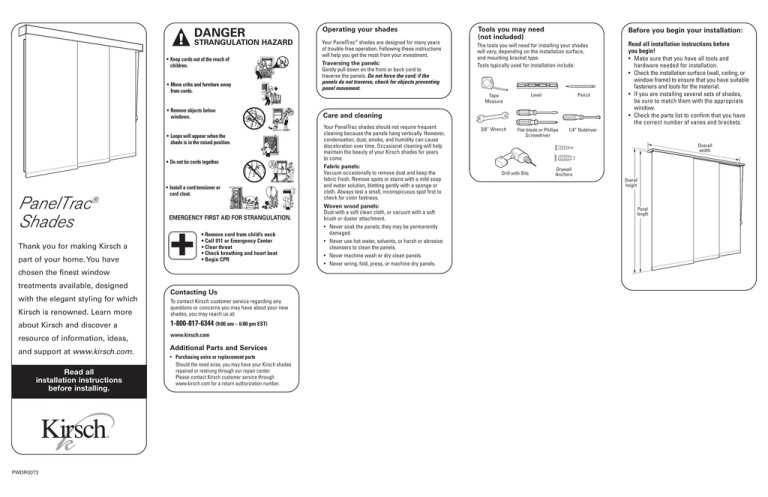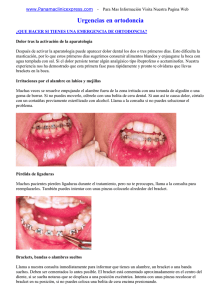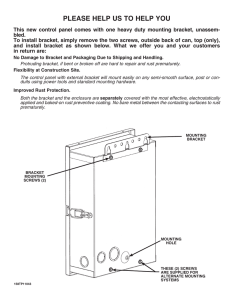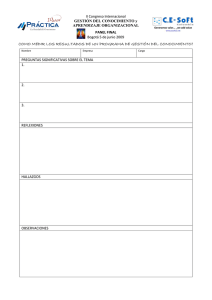PanelTrac® Shades - Wallpaper Wholesaler
Anuncio

DANGER Operating your shades STRANGULATION HAZARD Your PanelTrac® shades are designed for many years of trouble-free operation. Following these instructions will help you get the most from your investment. Traversing the panels: Gently pull down on the front or back cord to traverse the panels. Do not force the cord; if the panels do not traverse, check for objects preventing panel movement. • Keep cords out of the reach of children. • Move cribs and furniture away from cords. • Remove objects below windows. • Loops will appear when the shade is in the raised position. • Do not tie cords together. PanelTrac® Shades Thank you for making Kirsch a part of your home. You have • Install a cord tensioner or cord cleat. EMERGENCY FIRST AID FOR STRANGULATION. + • Remove cord from child’s neck • Call 911 or Emergency Center • Clear throat • Check breathing and heart beat • Begin CPR chosen the finest window treatments available, designed with the elegant styling for which Contacting Us Kirsch is renowned. Learn more To contact Kirsch customer service regarding any questions or concerns you may have about your new shades, you may reach us at: about Kirsch and discover a 1-800-817-6344 (9:00 am – 6:00 pm EST) resource of information, ideas, www.kirsch.com and support at www.kirsch.com. Read all installation instructions before installing. PWDR0073 Additional Parts and Services • Purchasing extra or replacement parts Should the need arise, you may have your Kirsch shades repaired or restrung through our repair center. Please contact Kirsch customer service through www.kirsch.com for a return authorization number. Tools you may need (not included) Before you begin your installation: The tools you will need for installing your shades will vary, depending on the installation surface, and mounting bracket type. Tools typically used for installation include: Read all installation instructions before you begin! • Make sure that you have all tools and hardware needed for installation. • Check the installation surface (wall, ceiling, or window frame) to ensure that you have suitable fasteners and tools for the material. • If you are installing several sets of shades, be sure to match them with the appropriate window. • Check the parts list to confirm that you have the correct number of vanes and brackets. Tape Measure Level Pencil 3/8” Wrench Flat-blade or Phillips Screwdriver 1/4” Nutdriver Care and cleaning Your PanelTrac shades should not require frequent cleaning because the panels hang vertically. However, condensation, dust, smoke, and humidity can cause discoloration over time. Occasional cleaning will help maintain the beauty of your Kirsch shades for years to come. Fabric panels: Vacuum occasionally to remove dust and keep the fabric fresh. Remove spots or stains with a mild soap and water solution, blotting gently with a sponge or cloth. Always test a small, inconspicuous spot first to check for color fastness. Woven wood panels: Dust with a soft clean cloth, or vacuum with a soft brush or duster attachment. • Never soak the panels; they may be permanently damaged. • Never use hot water, solvents, or harsh or abrasive cleansers to clean the panels. • Never machine wash or dry clean panels. • Never wring, fold, press, or machine dry panels. Overall width Drill with Bits Drywall Anchors Overall height Panel length These installation instructions apply for the following headrail styles: Two Channel 2B 4A Mark the bracket locations— inside or ceiling mount NOTE: for wide windows and sliding glass doors, two people are recommended for installing the headrail. • With the bracket arm positioned as shown, and the hook and loop strips on the panel carriers facing out, fit the tabs into the channel on the top of the headrail. You may need to turn the bracket arm slightly to line up the tabs with the channel. • Position one bracket at each end of the headrail, 4″ in from the ends. • Space any remaining brackets evenly, not more than 48″ apart. • Mark the bracket locations, making sure they are in a straight line that is parallel to the wall. Three Channel Attach the headrail— outside mount 4" 48" max. 5 Attach the panels Remove the panels from their packaging. Draw the cord so that the carriers are traversed across the entire headrail. Install one panel at a time, working from back to front. • Unroll a panel completely to expose the hook and loop strip a the top of the panel. • Attach the panel hook and loop strip on the backmost carrier, starting at one end and pressing the strips together. 7 Install the optional valance (not for all models) A - Attach the valance clips: • Starting at one end, hold the valance clip at an approximately 45°angle to the headrail, then hook the tabs into the channel on the front of the headrail. • Rotate the valance clip to lock it into place. • Space the remaining valance clips evenly along the length of the headrail. 4" Four Channel 1 Five Channel Determining the correct distance from the wall or window: Position the center of the brackets a min. 21⁄4″ in front of the window frame or any protruding trim or handles. Mounting brackets 3A Inside/Ceiling Mount Bracket Proceed to 2B Wall Bracket Proceed to 2A 2A Inside mount bracket • Position one bracket at each end of the headrail, 4″ in from the ends. • Space any remaining brackets evenly, not more than 48″ apart. • Mark the bracket mounting hole locations at the desired height, making sure they are level and square. Allow at least 1/2″ clearance for panels above the floor or sill. 4" 48" max. 4" Wall Bracket Screws (2 per bracket) Wall bracket Drywall anchor 3B Bracket arm • Turn the bracket arm until the tabs lock the headrail to the bracket. 4B Attach the headrail— inside or ceiling mount NOTE: for wide windows and sliding glass doors, two people are recommended for installing the headrail. • For models with a valance, the valance clips must be installed before attaching the headrail. See step 7 “A - Attach the valance clips”. • With the bracket arm positioned as shown, and the hook and loop strips on the panel carriers facing out, fit the tabs into the channel on the top of the headrail. You may need to turn the bracket arm slightly to line up the tabs with the channel. Install the brackets— inside or ceiling mount Example: Installation in a window frame using the included screws. • Using the marks made in step 2 as a guide, attach the brackets, using one screw per bracket. • Continue to step 4B. Top view Inside/ ceiling mount bracket Screw (1 per bracket) Top view • Repeat for the remaining panels. Install the brackets— outside mount Example: Installation using included screws and any needed fasteners or wall anchors. • Using the marks made in step 2 as a guide, attach the brackets, using two screws per bracket. • Continue to step 4A. Mark the bracket locations— outside mount Top view Valance clip Bracket arm • Turn the bracket arm until the tabs lock the headrail to the bracket. B - Attach returns (on some styles): To remove panels, grasp the top corner of the panel at the hook and loop strip and gently pull away from the carrier. Do not pull the fabric only; it may stretch or damage the panel at the hook and loop attachment. 6 NOTE: Check for proper return length before taping the fabric in place. Returns can be trimmed with heavy kitchen scissors, if needed. • Remove the tape holding the fabric to the back of the valance. • Holding the fabric out of the way, press the corner clip onto the end of the valance as shown. • Press the return piece into the corner clip, making sure the groovers face out. • Wrap the fabric around the return, tucking the edges into the groovers. • Peel the backing off the double sided tape on the fabric and tape the fabric to the back of the return. • Repeat for the other return. Corner Clip Attach the cord guide • Make sure that the cord has not wrapped around panel carriers in the headrail during shipping or installation. • Extend the cord fully downward and secure the guide to the wall or window frame with one of the included screws. The guide should be positioned so that the cord is fully extended without pulling on the headrail. Note Safety Warnings included. Fabric Wrap Return Panel C - Attaching the valance to the valance brackets: • Centering the valance over the headrail, slide the top of the front valance panel into the valance clips until the ridge on the valance locks into each clip. PELIGRO Cómo operar sus persianas PELIGRO DE ESTRANGULAMIENTO Sus persianas de PanelTrac® están diseñadas para muchos años de funcionamiento sin problemas. Si sigue estas instrucciones podrá obtener el máximo rendimiento de su inversión. Cómo cruzar los paneles: Tire suavemente del cordón frontal o trasero para cruzar los paneles. No fuerce el cordón. Si los paneles no se cruzan, verifique que no haya elementos impidiendo el movimiento. • Mantenga los cordones fuera del alcance de los niños. • Aleje cunas y muebles de los cordones. • Retire objetos ubicados debajo de las ventanas. • Aparecerán bucles cuando la persiana se encuentra en la posición elevada. • No ate los cordones. Persianas de PanelTrac® (paneles corredizos) Gracias por hacer que Kirsch sea parte de su hogar. Usted • Instale un tensor de cordones o una abrazadera de cordón. PRIMEROS AUXILIOS DE EMERGENCIA POR ESTRANGULAMIENTO + • Quite el cordón del cuello del niño • Llame al 911 o a un Centro de Emergencia • Despeje la garganta • Verifique la respiración y los latidos del corazón • Comience la resucitación cardiopulmonar ha elegido las persianas más refinadas del mercado, diseñadas con el estilo elegante que ha hecho famosa a Kirsch. Para saber más sobre Kirsch y descubrir una fuente de información, ideas y soporte, diríjase a www.kirsch.com Antes de iniciar la instalación, lea todas las instrucciones. PWDR0073 Para contactarnos Para contactar el servicio de atención al cliente de Kirsch en relación a cualquier consulta o pregunta sobre sus nuevas persianas, comuníquese con nosotros al: 1-800-817-6344 (9:00 am – 6:00 pm EST) www.kirsch.com Piezas y servicios adicionales • Para adquirir piezas extra o de repuesto Si surgiera la necesidad, puede hacer reparar o volver a hilar sus persianas Kirsch a través de nuestro centro de reparaciones. Contáctese con el servicio de atención al cliente de Kirsch en la dirección www.kirsch.com para obtener un número de autorización de devolución. Herramientas que puede necesitar (no incluidas) Las herramientas que necesitará para instalar sus persianas pueden variar, dependiendo de la superficie de instalación y del tipo de soporte de montaje. Las herramientas típicas utilizadas en la instalación son las siguientes: Lápiz Cinta métrica Nivel Llave de 3/8” Destornilladores de punta plana o Phillips Cuidado y limpieza Sus persianas de PanelTrac no requieren una limpieza frecuente porque cuelgan de manera vertical. Sin embargo, con el paso del tiempo la condensación, el polvillo, el humo, y la humedad pueden provocar una decoloración. Una limpieza esporádica lo ayudará a mantener la belleza de sus persianas Kirsch durante muchos años. Paneles de tela: Pase la aspiradora de vez en cuando para quitar el polvillo y mantener la tela en buenas condiciones. Quite las manchas con una solución de jabón suave y agua, secando suavemente con una esponja o paño. Siempre pruebe primero en una parte oculta para comprobar la inalterabilidad del color. Paneles de madera tejida: Limpie el polvillo con un paño suave o pase la aspiradora con un cepillo suave o accesorio para polvillo. • Nunca sumerja los paneles en líquido. • Nunca utilice agua caliente, solventes, o limpiadores abrasivos para limpiar los paneles. • Nunca lave en lavarropas o limpie a seco. • Nunca retuerza, doble planche los paneles, o seque con secarropas. Llave de tuercas de 1/4” Antes de iniciar la instalación: ¡Lea todas las instrucciones de instalación antes de comenzar! • Asegúrese de contar con todas las herramientas y los elementos necesarios para la instalación. • Verifique la superficie de instalación (pared, techo, o marco de la ventana) para garantizar que cuente con las sujeciones adecuadas y las herramientas necesarias para el material. • Si va a instalar varios juegos de persianas, asegúrese de colocarlas en la ventana correspondiente. • Controle la lista de piezas que acompaña al producto para confirmar que tenga la cantidad correcta de paletas y soportes. Ancho total Taladro con mechas Anclajes para construcción en seco Altura total Largo del panel Las instrucciones de esta instalación se aplican a los siguientes estilos de rieles superiores: Dos canales 2B Marque las ubicaciones del soporte: Montaje interno o en cielorraso • Coloque un soporte en cada extremo del riel superior, a 4” de los extremos. • Coloque los soportes restante a distancias uniformes, a no más de 48” entre sí. • Marque las ubicaciones de los soportes en la altura deseada, asegurándose de que estén nivelados y paralelos a la pared. Tres canales 4" 4A Sujete el riel superior: Montaje externo NOTA: Para ventanas anchas y puertas corredizas de vidrio, es recomendable que dos personas instalen el riel superior. • Con el brazo del soporte ubicado como puede verse, y las tiras de velcro sobre los conductores de panel hacia fuera, introduzca las lengüetas en el canal en la parte superior de riel superior. Quizás deba girar el brazo del soporte un poco para alinear las lengüetas con el canal. Máx. de 48” 48" max. 5 Sujete los paneles Quite los paneles de su envoltorio. Tire del cordón para que los conductores crucen a través de todo el riel superior. Instale un panel por vez, trabajando de atrás hacia adelante. • Desenrosque un panel por completo para exponer la tira de velcro ubicada en la parte superior del panel. • Sujete la tira de velcro sobre el conductor ubicado más atrás, comenzando en un extremo y presionando las tiras entre sí. 7 Instale el bastidor opcional (en algunos modelos) A - Sujete los ganchos para bastidor: • Comenzando en un extremo, sostenga el gancho del bastidor a un ángulo de 45° respecto del riel superior, luego introduzca las lengüetas en el canal ubicadas en el frente del riel. • Gire el gancho del bastidor y coloque en su lugar. • Coloque los restantes ganchos para bastidor de manera uniforme a lo largo del riel superior. 4" Cuatro canales Cinco canales Soporte de montaje interno 1 Soportes de montaje Soporte de pared Continué con el paso 2A 2A Para determinar la distancia correcta desde la pared o ventana: Coloque el centro de los soportes a 21⁄4” como mínimo frente al marco de la ventana o de cualquier clase de recorte o manijas. Soporte de montaje interno/cielorraso Continué con el paso 2B 3A 4" Máx. de 48” 48" max. 4" Soporte de pared Instale los soportes: Montaje externo Tornillos (2 por soporte) • Coloque un soporte en cada extremo del riel superior, a 4” de los extremos. • Coloque los soportes restante a distancias uniformes, a no más de 48” entre sí. • Marque las ubicaciones de los orificios de montaje de los soportes en la altura deseada, asegurándose de que estén nivelados. Deje un espacio de 1/2” para paneles sobre el piso o reliz. Soporte de pared Anclaje para construcción en seco 3B Brazo del soporte Instale los soportes: Montaje interno o en cielorraso 4B Sujete el riel superior: Montaje interno o en cielorraso NOTA: Para ventanas anchas y puertas corredizas de vidrio, es recomendable que dos personas instalen el riel superior. • En modelos con bastidor, los ganchos para bastidor deben instalarse antes de sujetar el riel superior. Vea el paso 7 “A: Sujete los ganchos para bastidor”. • Con el brazo del soporte ubicado como puede verse, y las tiras de velcro sobre los conductores de panel hacia fuera, introduzca las lengüetas en el canal en la parte superior de riel superior. Quizás deba girar el brazo del soporte un poco para alinear las lengüetas con el canal. Ejemplo: Instalación en el marco de una ventana utilizando los tornillos incluidos. • Utilizando las marcas hechas en el paso 2 como guía, sujete los soportes, usando un tornillo por soporte. • Siga con el paso 4B. Vista superior Soporte de montaje interno o en cielorraso Tornillo (1 por soporte) • Repita para los paneles restantes. • Gire el brazo del soporte hasta que las lengüetas traben el riel dentro del soporte. Ejemplo: Instalación utilizando tornillos incluidos y cualquier clase de sujetadores o anclajes para construcción en seco. • Utilizando las marcas hechas en el paso 2 como guía, sujete los soportes, usando dos tornillos por soporte. • Siga con el paso 4A. Marque las ubicaciones del soporte: Montaje externo Vista superior Gancho para bastidor Brazo del soporte • Gire el brazo del soporte hasta que las lengüetas traben el riel dentro del soporte. Vista superior B - Sujete los retornos (en algunos diseños): Para quitar paneles, tome la esquina superior desde la tira de velcro y suavemente tire hacia afuera. No sólo tire de la tela; puede rayar o dañar el panel en el accesorio de velcro. 6 Sujete la guía del cordón • Verifique que el cordón no se haya enroscado en los conductores en el riel superior durante el transporte o la instalación. • Extienda el cordón totalmente hacia abajo y sujete la guía a la pared o marco de la ventana con uno de los tornillos incluidos. La guía debe estar colocada de manera que el cordón esté completamente extendido sin colgar del riel superior. Vea las advertencias de seguridad incluidas. NOTA: Verifique el largo de los retornos antes de colocar la tela en su lugar. Los retornos pueden recortarse con tijeras de cocina grandes, si hiciera falta. • Quite la cinta que sostiene la tela en la parte trasera del bastidor. • Sosteniendo la tela de manera que no obstruya, presione el gancho de esquina en un extremo del bastidor, como puede verse. • Presione el retorno en el gancho de esquina, verificando que las ranuras miren hacia fuera. • Envuelva la tela alrededor del retorno, colocando los extremos dentro de las ranuras. • Despegue la parte trasera de la cinta de dos lados y pegue la tela a la parte trasera del retorno. • Repita por el otro retorno. Gancho de esquina Envoltura de la tela Panel de retorno C - Cómo sujetar el bastidor a los soportes de bastidor: • Centrando el bastidor sobre el riel superior, deslice la parte superior del panel del bastidor dentro de los ganchos para bastidor hasta que el borde del bastidor se inserte en cada gancho.


